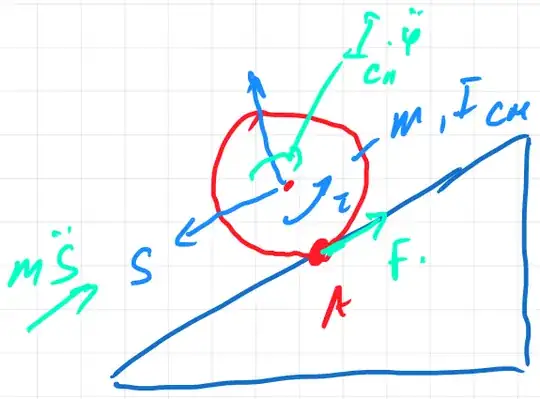The expression $ \underline{M}_c = \mathrm{I}_c \,\underline{\omega}$ is never correct. I think you forgot the time derivative of rotational velocity here. Also, the are Coriolis torques that relate to the rotation of the rigid body
$$ \underline{M}_c = \mathrm{I}_c \,\underline{\dot{\omega}} + \underline{\omega} \times \mathrm{I}_c \underline{\omega} \tag{1}$$
This relates the net moment on the body $\underline{M}_c$ to the angular acceleration of the body $\underline{\dot{\omega}}$ and it similar to Newton's 2nd law $\underline{F} = m\, \underline{\dot{v}}_c$. Both together form the Newton-Euler equations of motion for the rigid body.
This is derived from the differentiation of
$$ \underline{M}_c = \tfrac{\rm d}{{\rm d}t} \underline{L}_c = \tfrac{\rm d}{{\rm d}t} \left( \mathrm{I}_c \underline{\omega} \right) = \mathrm{I}_c \tfrac{\rm d}{{\rm d}t} \left( \underline{\omega} \right) + \tfrac{\rm d}{{\rm d}t} \left( \mathrm{I}_c \right) \underline{\omega} $$
Care must be taken to sum the moments about the center of mass, evaluate the mass moment of inertia tensor about the center of mass, and express all quantities on the same basis vectors (same orientation).
The only simplification for (1) is when the rotation $\underline{\omega}$ coincides with a principal axis of rotation. Then the second term is dropped, as is the case for the 2D planar projection of (1).
When considering an arbitrary point b not at the center of mass, then rotational equations of motion become slightly more complex
$$ \underline{M}_{b} = {\rm I}_{b}\,\underline{\dot{\omega}}+\underline{\omega}\times{\rm I}_{b}\,\underline{\omega}+\underline{c}\times m\,\underline{\dot{v}}_{b} \tag{2}$$
where $\underline{c}$ is the position of the center of mass relative to b and $\mathrm{I}_b$ is the mass moment of inertia summed at b and $\underline{\dot{v}}_{b}$ is the acceleration of point b.
The above is an advantage if the acceleration of b is known, like in the case of a pin joint. In that case Newton's second law can be simplified because the acceleration of the center of mass is no longer needed
$$ \underline{F} =m\left(\underline{\dot{v}}_{b}-\underline{c}\times\underline{\dot{\omega}}+\underline{\omega}\times\left(\underline{\omega}\times\underline{c}\right)\right) \tag{3}$$
